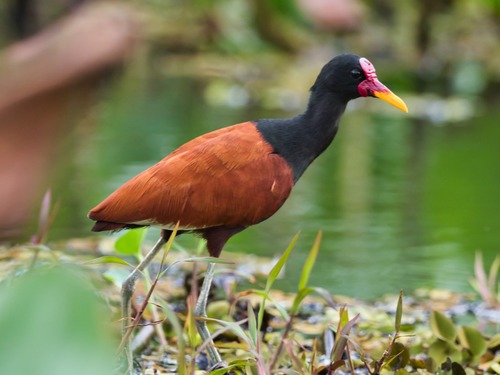
Wattled Jacana
The Wattled Jacana (*Jacana jacana*) is a striking wading bird renowned for its extraordinarily large feet and claws, which enable it to walk across floating vegetation in its freshwater wetland habitats. This species plays a crucial role in its ecosystem, primarily as an insectivore, helping to control insect populations. It's also known for its unique polyandrous mating system, where females mate with multiple males, who then take on the responsibility of incubating eggs and raising the chicks. Culturally, the Wattled Jacana is often seen as a symbol of adaptability and resourcefulness due to its specialized lifestyle.
17-25 cm
Length
40-48 cm
Wingspan
Least Concern
Conservation Status
Distribution
The Wattled Jacana is found throughout South America, east of the Andes, ranging from Panama and Trinidad south to Bolivia, Argentina, and Uruguay. They are non-migratory, though some populations may make local movements in response to water level changes.
Lifespan
Unknown in the wild; likely several years based on similar species.
Wattled Jacana's Habitat
Habitat Types
Freshwater marshes, Swamps, Lagoons, Flooded grasslands, Shallow lake edges with floating vegetation
Climate Zones
Tropical, Subtropical
Adaptations
Their exceptionally long toes and claws distribute their weight, allowing them to walk on floating vegetation such as lily pads and water hyacinths without sinking. This adaptation is crucial for foraging and nesting in their wetland environments.
Variations
Several subspecies are recognized, differing slightly in size and plumage coloration. For instance, *Jacana jacana hypomelaena* found in western Panama and northern Colombia is darker overall.
Appearance
Breeding Plumage
Adults have chestnut-colored backs and wings, with the rest of the body being primarily black. The flight feathers are greenish-yellow, visible during flight. There is little difference between breeding and non-breeding plumage.
Seasonal Feather Changes
No significant seasonal variations in plumage.
Sex Based Plumage Differences
While both sexes share similar coloration, females are larger. Juveniles are duller, with brown upperparts and whitish underparts.
Notable Features
Extremely long toes and claws, Reddish frontal shield and yellow wattle, Sharp wing spurs used in defense
Diet and Feeding
Primary Foods
Insects, Invertebrates, Seeds, Small aquatic animals
Foraging Behavior
Wattled Jacanas primarily forage by walking on floating vegetation and picking food items from the surface or just below. They may also probe in the mud or shallow water.
Specializations
Their long toes are their primary specialization, enabling their unique foraging style on floating vegetation.
Seasonal Diet Variations
Diet may shift slightly depending on the availability of insects and seeds throughout the year, but they remain primarily insectivorous.
Behavior
Social Structure
Wattled Jacanas exhibit a polyandrous mating system, where females mate with multiple males. Males are territorial, defending small areas around their nests.
Communication
Loud, raucous calls, Wing flapping displays, Use of wing spurs in aggressive encounters
Migration
Wattled Jacanas are generally non-migratory, but may undertake local movements in response to changing water conditions.
Territorial or Group Behaviors
Males defend small territories around their nests. Females may defend larger territories encompassing multiple male territories.
Conservation
Threats
Habitat loss due to wetland drainage, Pollution of wetlands, Agricultural expansion
Protection Programs
Wetland conservation and restoration efforts, Protected areas within their range
Local National Laws
Protected under various national wildlife laws in South American countries.
Population Trend
Stable
Population Estimates
Although widespread, precise population estimates are challenging. The IUCN lists them as a species of Least Concern due to their relatively large range and adaptable nature.
Interesting Facts
Wattled Jacanas have one of the most striking examples of reversed sexual dimorphism among birds.
Females are significantly larger and more dominant than males, a characteristic linked to their polyandrous mating system.
Chicks can swim and dive underwater to escape predators.
This behavior is crucial for survival in their open wetland habitats.
They are sometimes nicknamed 'lily-trotters' due to their ability to walk on floating vegetation.
This name reflects their unique adaptation to their wetland environment.
Faqs about Wattled Jacana
What is the purpose of the Wattled Jacana's large feet?
Their large feet and long toes distribute their weight, allowing them to walk on floating vegetation without sinking.
Do Wattled Jacanas migrate?
They are generally non-migratory but may move locally in response to water level changes.
What is unique about their mating system?
They have a polyandrous mating system, where females mate with multiple males, and males are responsible for incubation and chick care.
What do they eat?
Their diet consists primarily of the insects, invertebrates, seeds, and small aquatic animals that they find on or near floating vegetation.
Copyright @ Nature Style Limited. All Rights Reserved.
 English
English